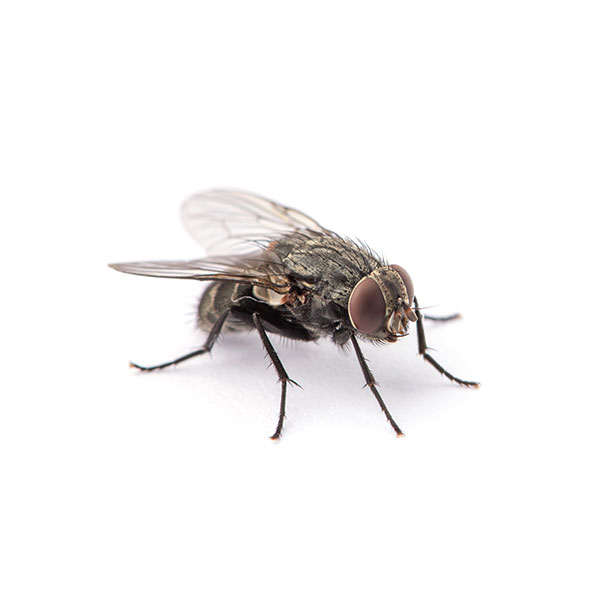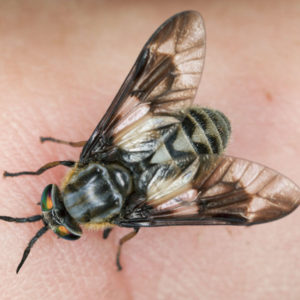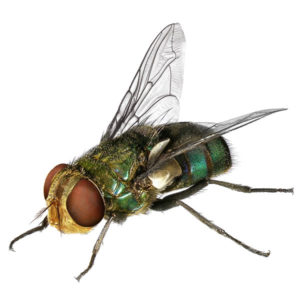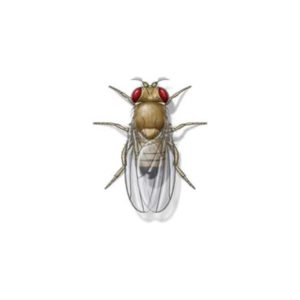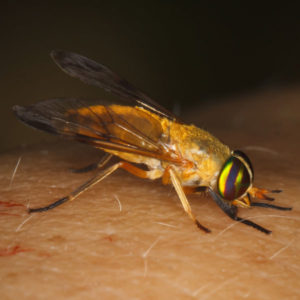Found on every continent except Antarctica, the house fly (scientifically known as Musca domestica) is one of the most familiar of all insects. House flies are generally found in the greatest numbers during the hotter summer months and generally live in close proximity to humans and animals. While often regarded as a nuisance due to their constant buzzing and presence around food, house flies can also pose health risks by transmitting disease-causing pathogens.
House flies breed in animal wastes and decaying organic material, including animal corpses and food waste from which they can pick up bacteria and viruses that may cause human disease. House flies defecate almost every time they land, contaminating food, with the potential to spread disease.
Unsure on the type of fly you are dealing with? Take a look at the most common flies found in North Carolina to help identify the specific fly species.
House Fly Identification
What Do House Flies Look Like?
House flies are medium-sized insects, typically measuring between 1/8 to 1/4 inch in length. They have a gray thorax adorned with four distinctive black stripes. Their bodies are covered in short, bristly hairs, and they have large, compound eyes that are red in color. Additionally, house flies have transparent wings with visible veins.
Signs of a House Fly Infestation
Signs of a house fly infestation are often visible both indoors and outdoors. Indoors, one may observe an abundance of flies congregating around food sources, garbage bins, or areas with organic debris. Additionally, house fly larvae, known as maggots, may be present in decaying organic matter, such as food waste, animal feces, or compost piles. Outdoors, large numbers of flies may be seen around garbage cans, animal pens, or decaying vegetation.
Habitat, Diet, Lifecycle & Bites
Where Do House Flies Live?
House flies prefer environments with access to food, moisture, and suitable breeding sites. They are commonly found in and around homes, farms, food processing facilities, and commercial establishments. House flies breed in decaying organic matter, such as garbage, animal waste, compost heaps, or sewage. They are particularly attracted to warm, moist conditions, making kitchens, bathrooms, and areas with food residue prime habitats.
Diet of a House Fly
House flies are opportunistic feeders and consume a wide variety of organic materials. Their diet includes decaying organic matter, food scraps, animal feces, sugary substances, and even secretions from wounds or sores. They use their sponge-like mouthparts to liquefy solid foods before ingesting them. House flies are attracted to odors and moisture, which guide them to potential food sources.
Life Cycle of a House Fly
The life cycle of a house fly consists of four stages: egg, larva (maggot), pupa, and adult. Female house flies lay their eggs in moist, organic material, such as rotting food or animal waste. The eggs hatch into larvae within 24 hours, and the larvae feed voraciously on the surrounding organic matter. After several days of feeding and molting, the larvae enter the pupal stage, where they undergo metamorphosis into adult flies. The entire life cycle can be completed in as little as 7 to 10 days under optimal conditions.
House Fly Bites
House flies do not bite humans or animals in the same manner as mosquitoes. Instead, they use their sponge-like mouthparts to feed on liquids. While house flies do not bite, their feeding behavior can still pose health risks. They can transmit disease-causing pathogens through contact with contaminated surfaces, food, or wounds, contributing to the spread of diseases such as diarrhea, dysentery, and food poisoning.
Are House Flies Dangerous?
House flies are considered potential vectors of disease due to their habit of feeding and breeding in unsanitary environments. They can harbor and transmit a variety of pathogens, including bacteria, viruses, and parasites, which may cause illnesses in humans and animals. House flies can pick up pathogens from their breeding sites, such as feces, and transfer them to food and surfaces through contact with their bodies and feces.
How to Get Rid of House Flies?
To get rid of house flies, employ a multi-pronged approach. Firstly, eliminate breeding grounds by disposing of organic waste promptly and keeping trash bins tightly sealed. Use fly screens on windows and doors to prevent entry, and repair any damaged screens. Employ fly traps or sticky flypapers strategically placed in areas of high fly activity. Regularly clean surfaces to remove food debris and spills that attract flies. Consider natural repellents like essential oils or herbs to deter flies. Lastly, maintain good hygiene practices and promptly clean up pet waste.
If you are dealing with a persistent house fly problem on your property, contact your local fly exterminators.
House Fly Prevention Tips
Preventative measures are key in reducing the risk of house fly infestations:
- Maintain Cleanliness: Practice good sanitation habits by cleaning up spills, removing food residues, and disposing of garbage promptly.
- Seal Entry Points: Seal gaps and cracks in doors, windows, and walls to prevent flies from entering indoor spaces.
- Remove Breeding Sites: Eliminate sources of organic matter, such as decaying food, animal waste, and compost piles, to discourage fly breeding.
Install Screens: Install window screens and door sweeps to prevent flies from entering indoor areas while allowing for ventilation.
Need help with House Flies control?
FAQs
Why Do I Have So Many House Flies All of a Sudden?
A sudden increase in house fly activity may be attributed to various factors, including warmer weather, nearby breeding sites (such as garbage or animal waste), or changes in sanitation practices that create favorable conditions for fly reproduction.
How Can I Stop Flies in My House?
To reduce house fly populations indoors, focus on eliminating food and breeding sources, maintaining cleanliness, and implementing physical and chemical control methods as needed.
Should I Worry About Flies in My House?
While house flies themselves may not pose a direct threat to human health, they can contribute to the spread of disease-causing pathogens and contaminate food and surfaces. Taking proactive measures to control fly populations can help minimize health risks and maintain a sanitary living environment.

